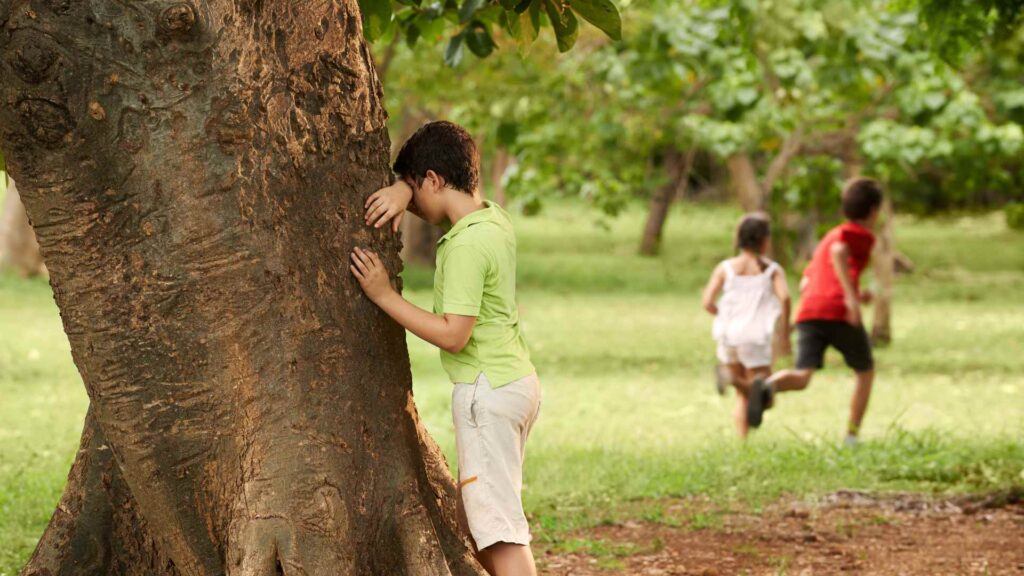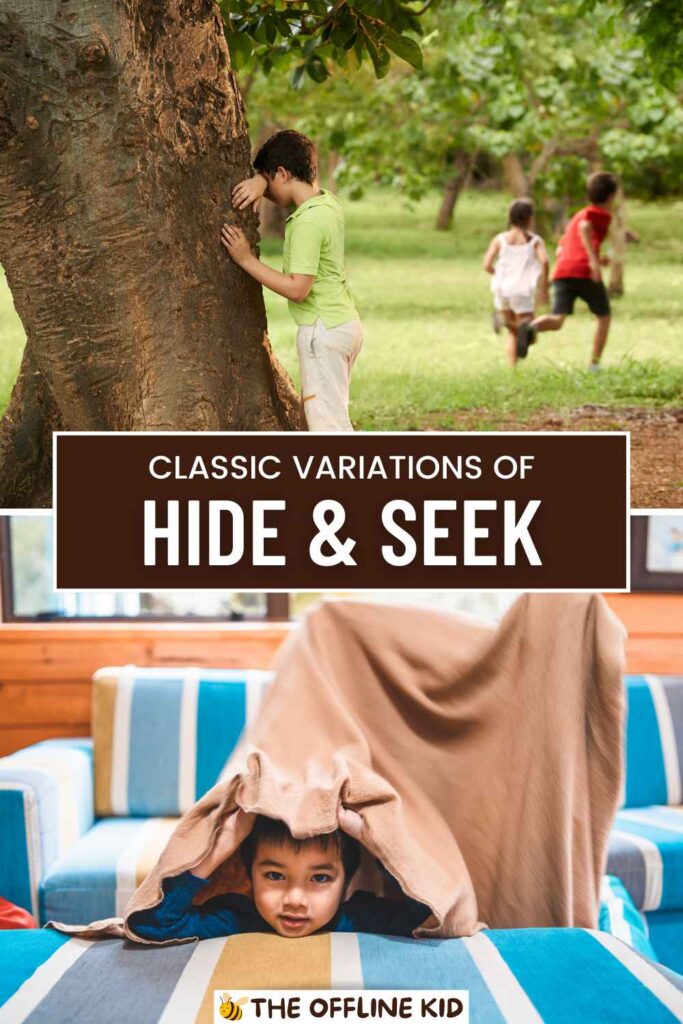Discover the timeless joy of Hide & Seek with these exciting variations.
From indoor adaptations to outdoor adventures, keep the fun alive for kids of all ages!
Basic Rules of Classic Hide & Seek
Overview of Classic Hide & Seek
Hide & Seek is a beloved game played by children worldwide. The rules are simple yet captivating, making it a staple of childhood play.
- Number of Players: Typically, Hide & Seek requires at least three players, but the more, the merrier!
- General Rules:
- One player is chosen to be “It” (the seeker).
- The seeker closes their eyes and counts to a predetermined number while the other players hide.
- After counting, the seeker opens their eyes and tries to find all the hidden players.
- Objectives:
- For Hiders: Find a good hiding spot and stay hidden until the seeker finds everyone else.
- For the Seeker: Locate all the hidden players in the shortest time possible.
Setting Up the Game
Proper setup is key to ensuring a fun and safe game of Hide & Seek.
- Choosing the Play Area:
- Indoor spaces like living rooms, basements, or classrooms.
- Outdoor areas like backyards, playgrounds, or parks.
- Safety Considerations:
- Ensure the area is free of hazards (sharp objects, traffic, unstable structures).
- Set clear boundaries to keep everyone within a safe and manageable space.
- Defining Boundaries and “Home Base”:
- Mark out the boundaries within which players can hide.
- Designate a “home base” where the seeker starts counting and where hiders can run to for safety.
With these basics in place, players are ready to dive into the classic game of Hide & Seek, setting the stage for endless variations and adaptations that keep the game exciting and new!

Hide & Seek Variations for Indoor Play
Sardines
Sardines is a fun and unique twist on the traditional game of Hide & Seek, perfect for indoor play.
- Description and Rules:
- Instead of one seeker, there’s only one hider.
- All the other players (the seekers) count while the hider finds a spot.
- Once the counting is done, the seekers start looking for the hider.
- When a seeker finds the hider, they join them in the hiding spot.
- The game continues until the last seeker finds the group crammed together like sardines in a can!
- Ideal Indoor Settings:
- Bedrooms, basements, or large indoor areas with plenty of hiding spots.
- Avoid areas with delicate or breakable items.
- Fun Tips for Playing:
- Dim the lights to add a bit of mystery and challenge.
- Play some background music to mask the sound of footsteps and whispers.
Reverse Hide & Seek (Seeker’s Hide)
Reverse Hide & Seek, also known as Seeker’s Hide, flips the traditional game on its head, offering a refreshing indoor variation.
- How It Works:
- One player hides while the others count.
- Once the counting is done, all the seekers spread out to find the hider.
- When a seeker finds the hider, they quietly join them in hiding.
- The last player to find the group becomes the next hider.
- Variations Within This Variation:
- Timed Version: Set a timer for how long the seekers have to find the hider.
- Tag Version: The first seeker to find the hider tags them and then becomes the next hider.
- Why It’s Fun Indoors:
- Encourages quiet, sneaky movements, perfect for indoor settings.
- Builds anticipation as the hiding spot becomes more crowded.
Hide & Clap (Inspired by The Conjuring)
Adding a spooky twist, Hide & Clap is inspired by the movie “The Conjuring” and brings an extra layer of excitement to indoor Hide & Seek.
- Game Mechanics:
- One player is blindfolded and becomes the seeker.
- The seeker counts to a designated number while the hiders spread out.
- The seeker can call out “clap” up to three times, and the hiders must clap their hands each time.
- The seeker uses the sound of the claps to locate the hiders.
- Adding a Spooky Twist:
- Play in a dimly lit or darkened room.
- Use spooky sound effects or background music to enhance the atmosphere.
- Best Environments for Play:
- Large, clutter-free rooms where players can move safely even when blindfolded.
- Avoid areas with obstacles that could cause tripping or injury.
Indoor Hide & Seek variations like these keep the classic game fresh and exciting, providing endless entertainment for kids.
Whether squeezing together in Sardines or sneaking around in Seeker’s Hide, these adaptations bring a new dimension of fun to any indoor setting.

Outdoor Hide & Seek Variations
Flashlight Hide & Seek
Flashlight Hide & Seek takes the thrill of the game to new heights by playing in the dark, adding an element of suspense and adventure.
- Nighttime Excitement:
- Play after sunset for an added thrill.
- Each seeker is equipped with a flashlight to help them find the hiders.
- Safety Tips for Playing in the Dark:
- Ensure the play area is free of hazards and well-known to all players.
- Set clear boundaries to prevent players from wandering off.
- Equip each player with a whistle or other signaling device for emergencies.
- Equipment Needed:
- Flashlights for the seekers.
- Reflective clothing or accessories for visibility.
- Optional: glow sticks or LED armbands for added fun and safety.
Nature Hide & Seek
Nature Hide & Seek integrates the beauty of the outdoors, using natural elements to create unique hiding spots.
- Using Natural Elements for Hiding:
- Encourage players to blend in with their surroundings using trees, bushes, rocks, and other natural features.
- Teach kids about camouflage and how to use it effectively.
- Encouraging Outdoor Exploration:
- Promote curiosity and a sense of adventure by exploring different outdoor areas.
- Use the game as an opportunity to learn about local flora and fauna.
- Seasonal Adjustments:
- In spring and summer, take advantage of lush greenery and long daylight hours.
- In autumn, use fallen leaves and changing foliage to create new hiding spots.
- In winter, adapt the game for snowy landscapes, using snowbanks and drifts for hiding.
Team Hide & Seek
Team Hide & Seek adds a collaborative element to the game, fostering teamwork and strategy among players.
- How to Organize Teams:
- Divide players into two teams: hiders and seekers.
- Rotate roles after each round so everyone gets a chance to hide and seek.
- Benefits of Teamwork and Strategy:
- Encourage players to work together to find the best hiding spots.
- Develop strategic thinking as teams plan their moves and coordinate efforts.
- Variations for Larger Groups:
- Capture the Flag: Combine Hide & Seek with Capture the Flag elements. Each team hides a flag, and the opposing team must find it while hiding from seekers.
- Tag Team Hide & Seek: One team hides while the other seeks. If a seeker tags a hider, the tagged player joins the seeking team.
These outdoor variations of Hide & Seek make the game more dynamic and exciting, providing endless opportunities for fun and adventure. Whether playing under the stars with flashlights or blending into nature, these adaptations encourage kids to explore the great outdoors and develop new skills.
Hide & Seek with a Twist
Color Hide & Seek
Color Hide & Seek adds a vibrant twist to the traditional game, enhancing observation skills and making the game even more engaging.
- Rules and Gameplay:
- Before starting, choose a specific color.
- Hiders must find hiding spots that match or camouflage with the chosen color.
- The seeker counts to a designated number and then searches for players hiding in or near objects of the chosen color.
- How It Enhances Observation Skills:
- Players must carefully select hiding spots based on color, honing their attention to detail.
- Seekers develop sharper observation skills as they look for subtle color matches.
- Adapting It for Different Ages:
- For younger kids, choose primary colors and easily identifiable objects.
- For older kids, use more specific shades or patterns to increase the difficulty.
Freeze Hide & Seek
Freeze Hide & Seek combines elements of freeze tag with Hide & Seek, creating a dynamic and fast-paced game.
- Incorporating Freeze Tag Elements:
- The seeker counts while hiders find their spots.
- When the seeker finds a hider, they tag them, and the hider must freeze in place.
- Other hiders can “unfreeze” their frozen friends by tagging them, but must avoid being caught themselves.
- Rules and Strategies:
- Set a time limit for how long players can remain frozen before being automatically unfrozen.
- Encourage hiders to work together to free frozen players without getting caught.
- Making It More Challenging:
- Increase the number of seekers to add more difficulty.
- Play in larger areas to make it harder for hiders to reach frozen players.
Statue Hide & Seek
Statue Hide & Seek adds a playful twist by combining Hide & Seek with a game of statues, where hiders must remain perfectly still when spotted.
- Combining Hide & Seek with a Game of Statues:
- The seeker counts while the hiders find their spots.
- When the seeker spots a hider, the hider must freeze in place like a statue.
- The seeker tries to make the “statue” move or laugh by making funny faces, telling jokes, or lightly tickling them.
- Rules and Variations:
- If the hider remains perfectly still for a set amount of time, they are considered safe.
- If the hider moves or laughs, they join the seeker in finding the remaining players.
- Fun Ways to Play:
- Add themed statues, such as animals or characters, to make the game more imaginative.
- Use music to add an extra layer of challenge, requiring players to freeze when the music stops.
These Hide & Seek variations with a twist provide a fresh take on the classic game, keeping it exciting and challenging.
Whether blending in with colors, freezing in place, or transforming into statues, these adaptations ensure that kids never tire of playing Hide & Seek.

Hide & Seek for Learning and Development
Educational Hide & Seek
Educational Hide & Seek merges fun with learning, making it an ideal activity for promoting cognitive skills in children.
- Incorporating Learning Elements:
- Numbers and Letters: Hide flashcards or objects labeled with numbers and letters. Hiders must find and remember them to win.
- Vocabulary Words: Use vocabulary cards or objects representing new words. Players must find and read them aloud when caught.
- Math Problems: Create simple math problems that hiders must solve once they are found.
- How It Promotes Cognitive Skills:
- Enhances memory and recall abilities.
- Encourages problem-solving and critical thinking.
- Improves literacy and numeracy through playful interaction.
- Tips for Creating Educational Variations:
- Tailor the difficulty level to the age group and learning objectives.
- Use bright colors and engaging visuals to capture attention.
- Incorporate rewards for finding and correctly identifying educational items.
Hide & Seek for Toddlers
Adapt Hide & Seek for younger children, ensuring it’s safe, simple, and engaging for toddlers.
- Simplified Rules:
- Limit the hiding area to a single room or small, safe space.
- Shorten the counting time to keep the game moving quickly.
- Use larger, more obvious hiding spots.
- Safety and Supervision:
- Always have an adult or older child supervise the game.
- Ensure the play area is free from hazards and toddler-proof.
- Making It Fun for Younger Kids:
- Use stuffed animals or toys to hide with the toddlers, making it a game of finding their favorite friends.
- Incorporate songs or rhymes during the counting to maintain engagement.
- Celebrate every discovery with cheers and high-fives to encourage participation.
Problem-Solving Hide & Seek
Introduce elements of problem-solving to Hide & Seek, encouraging kids to think critically and creatively.
- Adding Puzzles and Clues:
- Hide puzzle pieces or clues around the play area.
- Hiders must find and solve these puzzles or follow clues to find the best hiding spots.
- Seekers can use the clues to locate the hiders.
- Encouraging Critical Thinking:
- Design puzzles that require logical thinking, pattern recognition, or spatial awareness.
- Incorporate riddles or scavenger hunt-style clues that lead to the next hiding spot.
- Examples of Problem-Solving Elements:
- Treasure Map Hide & Seek: Create a map with clues leading to hidden “treasures” and use it to find hiding spots.
- Mystery Hide & Seek: Incorporate a mystery story where players must solve clues to find the hidden “suspects.”
- Escape Room Style: Set up an area with locks or barriers that hiders must figure out how to bypass to reach their spots.
These educational and developmental variations of Hide & Seek not only make the game more enriching but also help children develop essential cognitive and problem-solving skills.
Whether incorporating numbers and letters or turning the game into a mini escape room challenge, these adaptations ensure learning is always part of the fun.

Seasonal and Holiday Hide & Seek Variations
Easter Egg Hide & Seek
Easter Egg Hide & Seek combines the excitement of a traditional egg hunt with the fun of Hide & Seek, making it a festive and enjoyable activity.
- Combining Easter Egg Hunts with Hide & Seek:
- Hide decorated Easter eggs around the play area.
- Each hider must find and collect a set number of eggs before seeking their hiding spot.
- The seeker counts while the hiders search for eggs and then hide with their collected eggs.
- Creative Ideas for Egg Hiding:
- Use a mix of obvious and tricky hiding spots to keep the game challenging.
- Incorporate different colors and sizes of eggs for variety.
- Add small prizes or notes inside some eggs for extra fun.
- Making It a Festive Event:
- Decorate the play area with Easter-themed decorations.
- Play cheerful music to enhance the festive atmosphere.
- Conclude the game with an Easter-themed snack or treat for all participants.
Halloween Hide & Seek
Halloween Hide & Seek adds a spooky twist to the classic game, making it perfect for the Halloween season.
- Spooky Themes and Costumes:
- Encourage players to dress in Halloween costumes for added fun.
- Set up themed hiding spots using Halloween decorations like fake tombstones, cobwebs, and pumpkins.
- Rules for a Halloween Twist:
- The seeker can be dressed as a “monster” or “ghost” to fit the theme.
- Use glow-in-the-dark accessories or flashlights to add a spooky effect.
- Players can earn extra points for scaring the seeker without getting caught.
- Safety Considerations for Nighttime Play:
- Ensure the play area is well-lit and free of obstacles.
- Provide reflective clothing or accessories for visibility.
- Keep a close eye on younger children to ensure they feel safe and comfortable.
Winter Wonderland Hide & Seek
Winter Wonderland Hide & Seek turns a snowy landscape into a magical play area, providing a unique and fun experience.
- Playing in the Snow:
- Bundle up in warm clothing and ensure everyone is dressed appropriately for cold weather.
- Use snowbanks, trees, and other natural features as hiding spots.
- Incorporating Winter Elements:
- Hide small, brightly colored objects in the snow for players to find before hiding.
- Create “igloos” or snow forts as designated hiding spots.
- Keeping It Safe and Warm:
- Set time limits for rounds to prevent players from getting too cold.
- Have a warm-up area with hot drinks and snacks available between rounds.
- Ensure all players know the boundaries and stay within them to avoid getting lost or wandering off.
These seasonal and holiday variations of Hide & Seek add a festive and thematic twist to the classic game, making it even more enjoyable for kids.
Whether hunting for Easter eggs, playing spooky Halloween games, or hiding in a winter wonderland, these adaptations provide unique and memorable experiences for children of all ages.
Conclusion
Recap of Key Points
Throughout this guide, we’ve explored a variety of Hide & Seek variations that add excitement, challenge, and educational value to the classic game. Here’s a quick recap of what we covered:
- Basic Rules of Classic Hide & Seek: Setting up the game, choosing play areas, and ensuring safety.
- Indoor Variations: Sardines, Reverse Hide & Seek, and Hide & Clap.
- Outdoor Variations: Flashlight Hide & Seek, Nature Hide & Seek, and Team Hide & Seek.
- Creative Twists: Color Hide & Seek, Freeze Hide & Seek, and Statue Hide & Seek.
- Educational and Developmental Games: Incorporating learning elements, adaptations for toddlers, and problem-solving challenges.
- Seasonal and Holiday Fun: Easter Egg Hide & Seek, Halloween Hide & Seek, and Winter Wonderland Hide & Seek.
Encouragement to Play
Hide & Seek is more than just a game; it’s a way for kids to develop important skills, foster creativity, and build lasting memories. Whether you’re playing indoors on a rainy day, exploring the great outdoors, or adding a festive twist for the holidays, there’s a Hide & Seek variation for every occasion.
- Try Out the Variations: Don’t be afraid to mix and match different rules and themes to create your unique version of Hide & Seek.
- Get Creative: Encourage kids to come up with their variations and rules. This not only makes the game more fun but also fosters their imagination and problem-solving skills.
Final Thoughts
The timeless nature of Hide & Seek ensures that it remains a beloved activity for generations. Its simplicity and adaptability make it a perfect game for any setting, occasion, or age group.
By introducing these variations, you can keep the game fresh and exciting, providing endless opportunities for fun and learning.
- Reflecting on the Timeless Nature of Hide & Seek: The game’s enduring appeal lies in its universal simplicity and the joy of discovery.
- Encouraging Creativity and Adaptation in Play: The best games are those that evolve with the players. Keep experimenting with new ideas and twists to make Hide & Seek your own.


